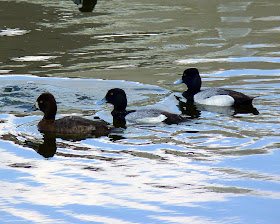Winter months bring a variety of seasonal residents to My Florida Backyard, including several varieties of diving ducks. In the fall, we had large numbers of Ring-Necked Ducks, but more recently, large flocks of Lesser Scaup have congregated in the lake out back.
The Lesser Scaup (Aythya affinis) is one of the most numerous diving ducks in North America. It is closely related to and difficult to tell apart from the Greater Scaup (A. marila), but the Greater Scaup is much less likely to be seen in this area, and is generally found on salt water. So our visitors are certainly Lesser Scaup (the plural of scaup is scaup, by the way).
Males (shown above, left) have more striking plumage, as is often is in the bird world, but both male and females have the bright blue bills that give this species the common name Bluebill. When the ducks first arrived in early winter, males had much duller plumage, and females had smaller sections of white near their bills. As mating season draws closer, the male's black and white feathers have become clearer and more defined, while the female's white bill patches have grown.
Lesser Scaup are noted for their interesting head shape, which almost seems to be squared off at times. At other times, though, their heads are more rounded. What explains this change in shape? It turns out that when a duck is relaxed, just paddling around and enjoying the sun, its head naturally takes on the squarer shape. When they tense up and prepare to dive, the head becomes more rounded, possibly making them more streamlined for the trip to the bottom of the pond. In the series of pictures below, compare the duck in the middle with the duck on the right to see this in action.
Lesser Scaup do not breed in Florida - they'll head north for the summer to breed there. Since we can see they are taking on the brighter plumage in preparation for mating, we can also expect them to begin their northern journey pretty soon. As spring approaches, they'll be off up the Mississippi Flyway to Northwest Canada, gone for another year. We'll look forward to seeing them again the in fall, when they bring their new offspring to enjoy the warmth of winter in My Florida Backyard.







Your lake certainly brings in a variety of water fowl. Very interesting. I have never seen or heard of these ducks. It's good to see that there are still some safe spots for migrating birds.
ReplyDelete